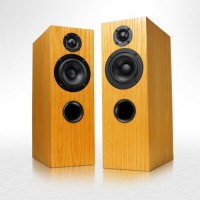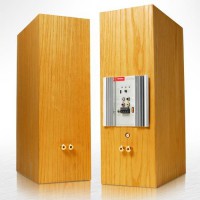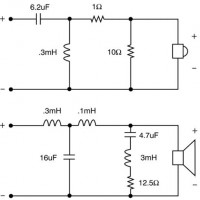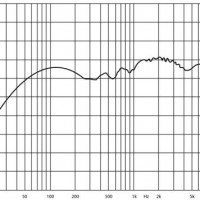TBD 2
Designer: Matt Phillips
Project Time: 8-20 hours
Project Complexity: Professional
Project Cost: $100-$500
Driver Selection
We received a new line of Tang Band underhung mid-bass drivers a few months ago and I took immediate interest. The specs on the W4-1720 were surprising for a 4″ driver and I decided to use that as my woofer. After minor break-in and measurement on the WT3, I calculated the recommended enclosure volume and realized it would be the perfect size to meet my requirements and get me well into the range I had hoped. To maintain a “mini” tower design, I was hoping to use a small flange soft dome tweeter. After looking at some reviews I decided on the Dayton Audio ND28F-6. I didn’t want the crossover point to be too high due to possible cone breakup issues with the woofer, so the 1-1/8″ size and relatively low FS would help with this.
Enclosure Design
Personally, I like the look of narrow, deep enclosures. I was planning on using real wood veneer as a finish, so rounded edges would not be used. The woofer is 4-15/16″ in diameter, so I decided on a baffle that is 6″ wide. This would also aid in the off axis response of the tweeters. The positioning of the speakers would require the tweeter to be between 16″ and 20″ from the TV stand they would be sitting on so I decided on a height of 18″. This also works well for the depth that would end up being 11″, and would allow me to cover both speakers with one 2′ by 8′ roll of veneer. With these external dimensions and two small braces, the net volume after displacement is roughly 0.35 cubic feet tuned to about 53 Hz using the 1-7/8″ diameter by 5-5/8″ long flared port, part number 260-476. This provides an F3 of about 48 Hz with typical damping.
Amplifier/Crossover Configuration
I hoped for a simple crossover design to keep costs down and the end result isn’t too hateful. There is a second order on the tweeter with a 3 dB L-Pad, and a third order on the woofer with a notch filter around 1000 Hz used mainly for baffle step compensation. I used Dayton Audio 1% poly caps and Jantzen 20 gauge air core inductors for the high end with Dayton Audio 10 watt audio grade resistors for the L-pad. For the low end I used electrolytic caps for the parallel connections and Jantzen 20 gauge air core inductors for the filter. Corner frequency for both drivers is ~3,500 Hz.
Enclosure Assembly
There is nothing too special about the construction. I was able to build both enclosures using one 3/4″ by 2′ by 4′ sheet of MDF, and a few scraps I had left over from other projects, so the building materials only cost about $15 to $20. As a side note, the standard for MDF thickness may have changed. I get my supply at the local Home Depot and it used to measure 3/4″ thick, and the sheet that I purchased for this project actually measured 11/16″ thick. Keep this in mind if your measurements are based off on a 3/4″ material thickness. I used standard butt joint construction, wood glue, and 1-5/8″ drywall screws to hold everything together. The braces are square pieces that join both sides and the top and bottoms of the enclosure together, and this proved to work very well even at higher volume levels. Recessed woofer cutout dimensions are 4-15/16″ OD at 1/8″ deep, with a through-hole cutout of 3-3/4″. Tweeter recess cutout dimensions are 2-9/16″ diameter at 3/32″ deep with a through-hole of 1-3/4″. I use the Jasper Circle Jig for all my holes and I always cut a test fit hole in a piece of scrap before I make the actual cutouts on the cabinet. I strongly recommend doing this and finding which ever dimensions give you the tightest fit. For damping materials I decided to try the 1/2″ Sonic Barrier self adhesive foam, part number 260-520. I only used one 18″ by 24″ sheet and divided it evenly between both cabinets, covering the tops, bottoms, sides and braces. This worked really well and I see no reason for any additional damping. For the finish I used the Band-It paper-backed white ash veneer and Minwax Polyshades polyurethane.
Conclusion
Bass extension was the main priority when I designed the system. It was the first thing I listened for and it would’ve been the first thing I noticed, regardless. The 4″ woofers can reproduce low-end that compares to most 6-1/2″ woofers, and it is very clean and detailed. I am able to follow bass guitar notes and riffs that I couldn’t even hear before. The punch is outstanding and I strongly believe they can take every bit of their rated 30+ watts. There should be no need for any tone adjustment. Now for the next thing on my list: the rest of the sound quality. I have never heard a 4″ bookshelf speaker with the sound stage and presence that these have. There is a bit of a peak that is faintly noticeable around 3k, but I can safely blame this on room reflections. I only notice it in a certain listening position in our bedroom, and haven’t noticed it in the other three rooms I tried. These far surpassed my original expectations and I can’t help but close my eyes and let the music surround me. These would also work well as high value pair of near field monitors, or a high quality set of computer speakers with a separate amp. The amplifier I am using is the Pyle Pro PTA2, and may be questionable to a lot of avid audiophile consumers, but I wanted something with a durable build quality and a few added inputs that I couldn’t find on the other budget amps I looked at. So far the amplifier has done very well and I have had no issues. Even with the low efficiency of these speakers (~85dB with 1 watt) and over rated power of this amp (4-6 watts/channel RMS), the PTA2 will drive these speakers to uncomfortable volume levels for most people, so that should be proof enough that you don’t need 100+ watts to get a lot of volume. In my opinion these don’t need a subwoofer, at least for an application similar to mine. I dare you to find a better sounding 4″ bookshelf speaker for less than $250/pr.
About The Designer
Matt Phillips has been an audio enthusiast for many years. His fascination with cutting-edge products and concepts has been strong ever since the beginning of his speaker building hobby. Building on experience gained from working at Parts Express, he continues to explore new concepts and applications. Matt’s other interests include woodworking, toying with RC cars, drumming for his local church’s praise band, and going to the shooting range.
Project Parts List
|
Part # |
Description |
Qty |
|
264-872 |
1 |
|
|
275-040 |
1 |
|
|
1 |
||
|
260-476 |
1 |
|
|
091-1245 |
1 |
|
|
004-1 |
Dayton Audio DNR-1.0 1 Ohm 10W Precision Audio Grade Resisto |
1 |
|
004-10 |
Dayton Audio DNR-10 10 Ohm 10W Precision Audio Grade Resisto |
1 |
|
004-12.5 |
Dayton Audio DNR-12.5 12.5 Ohm 10W Precision Audio Grade Res |
1 |
|
027-236 |
1 |
|
|
027-320 |
1 |
|
|
027-332 |
1 |
|
|
027-344 |
1 |
|
|
255-020 |
1 |
|
|
255-028 |
1 |
|
|
255-056 |
1 |





i WOULD LIKE TO KNOW YOUR THOUGHTS AS THE DESIGNER IF THESE WOULD BE SOMETHING FOR ME TO CONSIDER FOR MY HOME OFFICE NEAR FIELD COMPUTER STREAMING SPEAKERS. I AM THINK 6 FOOT APART [3’F OFF ECENT OF MY MONITOR, DESCK AND ME. TURNING THEM TOWARD ME AND SLIGHTLY ANGLED DOWNWARD AND ALWAYSD KEEPING THE TWEETER BELOW MY EARS..